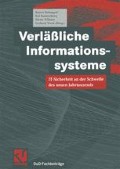Zusammenfassung
Zunächst wird die Spezifikationssprache XML und ihre Bedeutung für die Internet-Entwicklung vorgestellt. Ein wichtiger Aspekt von XML ist dabei, daß es den Zugang von Anwendungen zu Sicherungsinfrastrukturen vereinfachen kann. Dann geben wir einen Überblick über bestehende XML-Initiativen in verschiedenen IT-Sicherheitsbereichen. Als Beispiel für den Sicherheitsaspekt der Verbindlichkeit wird ein IETF-Entwurf für digitale Signaturen im Internet hervorgehoben.
Access this chapter
Tax calculation will be finalised at checkout
Purchases are for personal use only
Preview
Unable to display preview. Download preview PDF.
Literatur
ISO 8824/8825: Information Processing Systems — Open Systems Interconnection — Specification of Abstract Syntax Notation One, and Specification of Basic Encoding Rules ofASN.1. 1992. (s. also: CCITT X.208/X.209.)
Bruce Schneier: Applied Cryptography. Protocols, Algorithms, and Source Code in C. 2nd Ed. Wiley & Sons, Chichester 1996.
Brown, Richard: Digital Signatures for XML. Proposed Internet Standard RFC, January 1999, draft-brown-xml-dsig-OO.txt, 42 pages.
M. Geppert, A. Roßnagel: Telekommunikations-und Multimediarecht. Darin: TelekommunikationsG, TelediensteG, Telediensteda-tenschutzG, SignaturG, SignaturVO, Mediendienste-Staatsvertrag. Beck-Texte im dtv, München 1998.
Grimm, Rüdiger: Kryptoverfahren und Zertifizierungsinstanzen. In: Datenschutz und Datensicherheit (DuD) 1/96, Jan 1996, Vieweg Verlag, Wiesbaden, 27-36.
Dave Ragett et al: HTML 4.0 Specification. W3C Recommendation, Revised 24. April 1998, http://www.w3.org/TR/1998/REC-html40-19980424.
Informations-und Kommunikationsdienste-Gesetz (IuKDG). Be-schluß des Deutschen Bundestages vom 13. Juni 1997, http://www.iid.de/rahmen/index.html. Auszugsweiser Buchdruck in [GeRo98].
Patrick Ion et al: Mathematical Markup Language (MathML) 1.0 Specification. W3C Recommendation, 07. April 1988, http://www.w3.org/TR/1998/REC-MathML-19980407.
CheckFree Corp., Intuit Inc., Microsoft Corp.: Open Financial Exchange (OFX). Specification 1.5.1, November 23, 1998, 525 pages.
The Open Trading Protocol Consortium (OTP): Internet Open Trading Protocol. Version 0.9.9, 17. August 1998.
W3C Initiative: Platform for Privacy Preferences (P3P Project). W3C Working Draft, 7 April 1999, http://www.w3c.org/P3P/ and http://www.w3c.org/TR/WD-P3P/.
Internet IETF: Privacy Enhancement for Internet Electronic Mail. Part I-IV (“PEM”). RFC 1421-1424, Feb 93.
Zimmermann, Philip: Pretty Good Privacy — Public Key Encryption for the Masses. PGP User’s Guide. Vol. I: Essential Topics, 31 printed pages; Vol. II: Special Topics, 47 printed pages. PGP Version 2.6.1, 30. August 1994.
W3C Initiative: Platform for Internet Content Selection (PICS), March 1998, http://www.w3c.org/PICS/.
Chu, Yang-hua et al: PICS Signed Labels (Dsig). 1.0 Specification. W3C Recommendation, 27 May 1998, http://www.w3c.org/TR/PR-Dsig-label.
Ora Lassila et al: Ressource Description Framework (RDF). Model and Syntax Specification. W3C Proposed Recommendation, 5.1.99, http://www.w3.org/TR/1999/PR-rdf-syntax-19990105.
Kravitz, Jeff: SDML — Signed Document Markup Language. Version 2.0, W3C Note 19 June 1998, http://www.w3c.org/TR/NOTE-SDML.
Bundesamt für Sicherheit in der Informationstechnik, BSI: Spezifikation zur Entwicklung interoperabler Verfahren und Komponenten nach SigG/SigV. Signatur-Interoperabilitätsspezifikation Sigl, Abschnitt Al „Zertifikate”, Version 3.0, 31.1.1999.
Structured Generalized Markup Language, ISO 8879.
S/MIME Editor: S/MIME Message Specification — PKCS Security Services for MIME. Revised Feb 21, 1996, 11 pages. ftp://ftp.rsa.com/pub/S-MIME/smimemsg.doc.
ISO/IEC 9594, ITU X.500 (1988/92): Information technology — Open Systems Interconnection — The Directory 1993(E). Insb.: X.509 — The Authentication Framework.
Tim Bray et al: Extensible Markup Language (XML) 1.0. W3C Recommendation, 10. Februar 1998, http://www.w3.org/TR/1998/REC-xml-19980210.html.
W3C XML Activity. Extensible Markup Language — Activity Statement. 1998, http://www.w3c.org/XML/Activity.
Author information
Authors and Affiliations
Editor information
Rights and permissions
Copyright information
© 1999 Friedr. Vieweg & Sohn Verlagsgesellschaft mbH, Braunschweig/Wiesbaden
About this chapter
Cite this chapter
Grimm, R., Wasch, J. (1999). XML und IT-Sicherheit. In: Baumgart, R., Rannenberg, K., Wähner, D., Weck, G. (eds) Verläßliche Informationssysteme. DuD-Fachbeiträge. Vieweg+Teubner Verlag. https://doi.org/10.1007/978-3-322-90897-1_10
Download citation
DOI: https://doi.org/10.1007/978-3-322-90897-1_10
Publisher Name: Vieweg+Teubner Verlag
Print ISBN: 978-3-322-90898-8
Online ISBN: 978-3-322-90897-1
eBook Packages: Springer Book Archive

